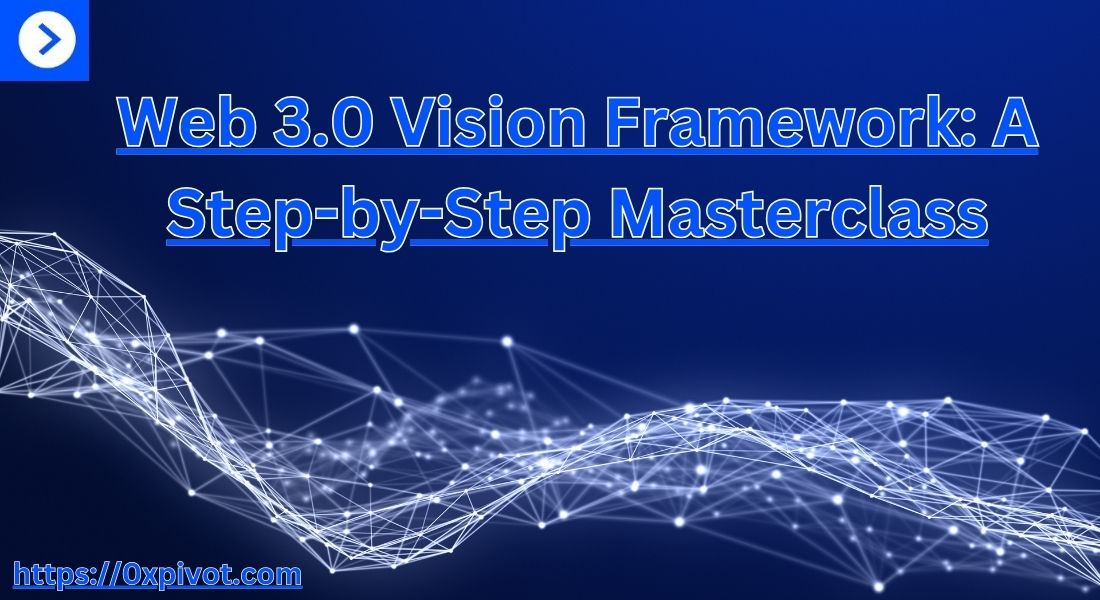Web 3.0 Vision Framework: A Step-by-Step Masterclass
 0xPivot
0xPivot
Web 3.0 is reshaping the digital landscape, emphasizing decentralization, user ownership, and community-driven content. In this masterclass, discover how to design a Vision Framework tailored to the Web 3.0 environment, focusing on essential strategies to shape the future of the web.
Understanding Web 3.0
Web 3.0 marks a transformative leap in the evolution of the internet. Unlike its predecessors—Web 1.0, which was largely static, and Web 2.0, which introduced interactivity and user-generated content (UGC)—Web 3.0 empowers users by giving them control over their data and digital assets. This shift towards a more democratized digital experience underscores the importance of decentralization and community-driven content.
The Importance of a Vision Framework
In the rapidly evolving Web 3.0 landscape, having a clear vision framework is crucial. This framework serves as a guiding star for organizations, helping them set objectives, inspire their teams, and develop strategies that foster both innovation and sustainable growth. Without a well-defined vision, organizations risk losing direction in this fast-paced environment.
Core Ideology: The Foundation of Success
At the heart of any successful organization lies a strong core ideology. This set of values and purpose remains constant, even as the organization evolves. For Web 3.0 companies, clearly defining what they stand for and how they intend to impact the digital world is vital for long-term success.
Envisioned Future: Setting Ambitious Long-Term Goals
A vision framework is incomplete without an envisioned future. This involves setting long-term goals that are both ambitious and realistic. By crafting a vivid description of what success looks like, organizations can provide their teams with a clear target to strive for, ensuring that everyone is aligned and moving in the same direction.
The Shift to a User-Generated Content Economy
One of the most significant shifts in Web 3.0 is the transition from a professionally-generated content (PGC) economy to a user-generated content (UGC) economy. This new model empowers users to take control and actively contribute to the digital content landscape. To succeed in this environment, organizations must align incentives with community goals and find innovative ways to monetize unique talents and interests.
Strategic Reevaluation in the Dynamic Web 3.0 Market
The Web 3.0 market is highly dynamic, requiring organizations to continuously reevaluate their strategies to stay competitive. This demands a robust infrastructure capable of adapting to changes, as well as a flexible mindset that embraces new opportunities. Learning from industry leaders who have successfully navigated these challenges can provide valuable insights for future success.
Big Hairy Audacious Goals (BHAGs) and the Kano Model
Big Hairy Audacious Goals (BHAGs) represent long-term, ambitious objectives that drive organizations towards greatness. When paired with the Kano model—which helps identify attributes that contribute to customer satisfaction—organizations can strategically balance their investments to maximize value and achieve sustainable success.
Building Strong Communities for Long-Term Success
In Web 3.0, a strong community is the backbone of any successful organization. Engaging with users, understanding their needs, and fostering a sense of belonging are critical for sustained growth. By leveraging user-generated content and incentivizing participation, organizations can build and maintain a thriving community that supports their long-term goals.
Balancing Ambition with Realism
While setting ambitious goals is important, maintaining a balance with realism is equally crucial. This ensures that organizations remain adaptable to changes while still striving for significant achievements. By setting realistic milestones and continuously reassessing progress, organizations can stay on track and achieve their long-term vision.
Applying Vision Framework Principles in the Real World
The principles of a vision framework are not just theoretical—they have real-world applications. Case studies of successful Web 3.0 companies demonstrate how these strategies can be effectively implemented to achieve organizational goals. By learning from these examples, organizations can tailor their own vision frameworks to suit their unique needs.
The Role of Leadership in Web 3.0
Leadership in Web 3.0 requires a unique set of skills. Leaders must be visionary, adaptable, and capable of inspiring their teams through clear communication and a strong sense of purpose. In a rapidly changing digital landscape, effective leadership is crucial for guiding organizations toward long-term success.
Integrating Innovation with Tradition
Innovation is the driving force behind Web 3.0, but it’s also important to integrate traditional strategies that have proven effective. A flexible mindset that embraces new ideas while respecting established methods can help organizations navigate the complexities of the Web 3.0 landscape and achieve sustainable growth.
Navigating Challenges in Web 3.0
Web 3.0 organizations face unique challenges, from regulatory hurdles to rapid technological advancements. Addressing these challenges with strategic planning and a clear vision can help organizations overcome obstacles and succeed in this new digital frontier.
Conclusion
Designing a vision framework for Web 3.0 is about more than just setting goals—it’s about creating a roadmap that guides an organization toward long-term success. By focusing on core ideology, community engagement, and strategic flexibility, organizations can navigate the evolving landscape of Web 3.0 and achieve sustainable growth.
Subscribe to my newsletter
Read articles from 0xPivot directly inside your inbox. Subscribe to the newsletter, and don't miss out.
Written by

0xPivot
0xPivot
Pivot is a global Web 3.0 startup accelerator and venture capital firm, empowering founders to build transformative Web 3.0 companies through expert-led programs, strategic mentorship, and robust funding opportunities.